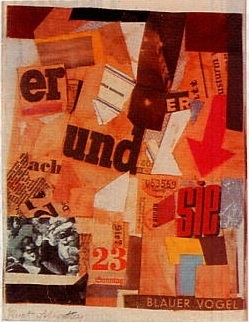collage
The definition of collage, as found in the Oxford English Dictionary, is “an abstract form of art in which photographs, pieces of paper, newspaper cuttings, string, etc. are placed in juxtaposition and glued to the pictorial surface; such a work of art" [1]. Although it is considered an "abstract form of art", the materials used are pictorial and textual representations of recognizable objects. When placed next to each other, however, these representations may lose their autonomous meaning by creating a new, collective [2].
Collage came into the focus of the art world in the 20th century, often employing the "object trouve", or the "found object", and fixing these objects on a two-dimensional surface. Art historians often attribute the conception of collage as a reflection of the disorientation that resulted from the pace of the modern world. The first use of collage in fine art came from Picasso in 1912, one example being "Still-Life with Chair-Caning", in which he used printed oil-cloth that looked like chair-caning, as well as a rope encircling the painting to form a frame.

Picasso's use of collage was followed by other Cubists, namely Juan Gris and Georges Braque. Picasso also began using cutouts from the newspaper, Le Journal, suggesting the implications of everyday events in art. Later in his career, Picasso being working with collage on three dimensional surfaces, as shown in his cardboard work, "Guitar" [3].

Humor and irony are important elements of collage, often expressed through textual puns. The use of text in collage is studied by Rosalind Krauss in her essay, "In the Name of Picasso." She asks, "Is the structure of cubist collage itself supportive of the semantic positivism that will allow it to be thus assimilated to the art history of the proper name? Or are the word-fragments that gather on the surface of Picasso's collages instead a function of a rather more exacting notion of reference, representation, and signification?" [4] The use of text complicates the timeless question of representation in art. As collage moved away from traditional art, concerns arose surrounding (and continue to surround) the critique of the medium due to "those concerned with the supposed transcendental quality of high art" [5]. Because of the defining multimedia aspect of collage, there is difficulty in formally analyzing collage in art historical terms. Consequently, collage is often referred to as postmodern. [6]
Collage has also been thought of as "the manifestation of a specific historical moment, a moment of crisis in consciousness" [7], both social and political. This specific historical moment can be called modernity, and is directly related to capitalism and reproduction. Walter Benjamin's discussion of mechanical reproduction in "The Work of Art in the Age of Reproduction", touches on a central argument surrounding collage. Certain types of collage incorporate images that come directly from mass production, including print culture and photography. "[Technical reproduction] also had captured a place of its own among the artistic processes. For the study of this standard nothing is more revealing than the nature of the repercussions that these two different manifestations-the reproduction of works of art and the art of the film-have had on art in its traditional form" [8]. Of these two manifestations, the former makes collage possible, the latter is a product of it, specifically in photography and montage. The dialogue between collage and capitalism politicizes the practice, paving the way for overtly political art in the form of collage.
Collage continued to be used by more experimental artist, particularly in the Dada movement. Kurt Schwitters, from the Berlin Dada group, used many found objects in his collages, often from the street.

The Berlin Dada group was known for using newspaper cutouts and photographs in a "political, satirical and socially critical fashion" [9]. Collage has also been used as political propaganda.
The social implications of the term collage are evident in the multiple meanings. A French word, sticking or gluing is the most common definition for collage, however, not necessarily the most interesting. In colloquial French, collage means "having an affair, or an unmarried couple 'living in sin'" [10]. Francis Frascina points out that in Cubist collage, "words and images cohabit, producing novel combinations and contexts" [11]. Moreover, collage demands interaction between the work and the viewer, and each one of these interactions are novel. The viewer recognizes the chair-caning and has had a personal, physical relationship with that object, unlike anyone else's experience. There is a sense of ownership in that respect. On the other hand, collage (as does much of modern art, I would argue) also reinforces interpersonal relationships, encouraging discussion of the formal qualities or the work, producing the sentiment of solidarity. And there is the sexiness of collage that Frascina alludes to with his colloquial definition; both the unmarried couple and the collage are capable of sense of randomness, even risk, that is not possible when there are strict structural restrictions.
Emily Bell
Winter 2007